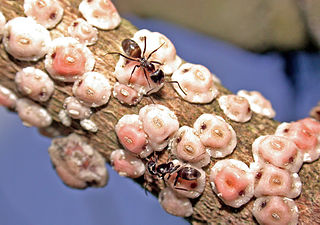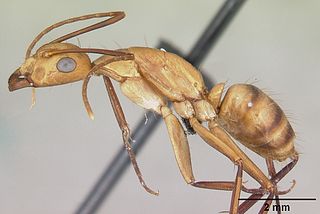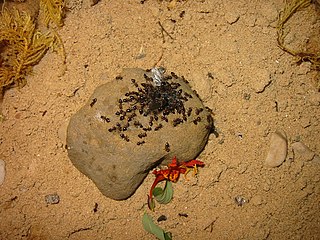Related Research Articles

The Indian pangolin, also called thick-tailed pangolin and scaly anteater is a pangolin native to the Indian subcontinent. Like other pangolins, it has large, overlapping scales on its body which act as armour. The colour of its scales varies depending on the colour of the earth in its surroundings. It can also curl itself into a ball as self-defence against predators such as the tiger. It is an insectivore feeding on ants and termites, digging them out of mounds and logs using its long claws, which are as long as its fore limbs. It is nocturnal and rests in deep burrows during the day.

Myrmarachne is a genus of ant-mimicking jumping spiders that was first described by W. S. MacLeay in 1839. They are commonly called ant-mimicking spiders, but they are not the only spiders that have this attribute. The name is a combination of Ancient Greek μύρμηξ, meaning "ant", and ἀράχνη, meaning "spider".

Myrmecophytes are plants that live in a mutualistic association with a colony of ants. There are over 100 different genera of myrmecophytes. These plants possess structural adaptations that provide ants with food and/or shelter. These specialized structures include domatia, food bodies, and extrafloral nectaries. In exchange for food and shelter, ants aid the myrmecophyte in pollination, seed dispersal, gathering of essential nutrients, and/or defense. Specifically, domatia adapted to ants may be called myrmecodomatia.

Dorymyrmex is a genus of ants in the subfamily Dolichoderinae.

The Chinese pangolin is a pangolin native to the northern Indian subcontinent, northern parts of Southeast Asia and southern China. It has been listed as Critically Endangered on the IUCN Red List since 2014, as the wild population is estimated to have declined by more than 80% in three pangolin generations, equal to 21 years. It is threatened by poaching for the illegal wildlife trade.

Crematogaster is an ecologically diverse genus of ants found worldwide, which are characterised by a distinctive heart-shaped gaster (abdomen), which gives them one of their common names, the Saint Valentine ant. Members of this genus are also known as cocktail ants because of their habit of raising their abdomens when alarmed. Most species are arboreal (tree-dwelling). These ants are sometimes known as acrobat ants.

Pseudomyrmex is a genus of stinging, wasp-like ants in the subfamily Pseudomyrmecinae. They are large-eyed, slender ants, found mainly in tropical and subtropical regions of the New World.

Carebara diversa, is a species of marauder ant widely distributed throughout Asia.

Ochetellus glaber is a species of ant native to Australia. A member of the genus Ochetellus in the subfamily Dolichoderinae, it was described by Austrian entomologist Gustav Mayr in 1862. Aside from Australia, O. glaber has been introduced to a number of countries, including China, India, Japan, New Zealand, the Philippines and the United States, where it has established itself in Hawaii and Florida. It has been found on Lord Howe Island, New Caledonia, Norfolk Island, Réunion and the Solomon Islands. Compared with other ants, O. glaber is a small species, with workers measuring 2–3 mm (0.079–0.118 in). Males are the smallest at 1.6 mm (0.063 in), while the queens measure 5.2–5.5 mm (0.20–0.22 in). The ant's colour ranges from brown to black.

Tetraponera is a genus of ants in the subfamily Pseudomyrmecinae that are commonly known as slender ants and are characterized by their arboreal nature and slender bodies. The 96 described species of Tetraponera all of which live in hollow structures of plants and trees, such as thorns or branches; these hosts are known as myrmecophytes. Tetraponera species are closely related to the New World genus of ants Pseudomyrmex, but differ in their relationships with host plants.

Crematogaster carinata is a species of ant in the tribe Crematogastrini. It was first described by Gustav Mayr in 1862. It is native to Central and South America, where it is a common species, forming large colonies in the canopy of the forest.
Camponotus irritans is a species of carpenter ant. It is found in many Asian and Oceanian countries.

Camponotus variegatus is a species of carpenter ant.

Cardiocondyla nuda is a species of ant in the subfamily Myrmicinae. It is a widespread ant species, and not invasive in nature.

Crematogaster rogenhoferi is a species of ant of the subfamily Myrmicinae that can be found in Sri Lanka.
Crematogaster rothneyi, is a species of ant of the subfamily Myrmicinae.
References
- 1 2 Dias, Ratnayake Kaluarachchige Sriyani; Guénard, Benoit; Akbar, Shahid Ali; Economo, Evan P.; Udayakantha, Warnakulasuriyage Sudesh; Wachkoo, Aijaz Ahmad (2020-09-14). "The Ants (Hymenoptera, Formicidae) of Sri Lanka: a taxonomic research summary and updated checklist". ZooKeys (967): 1–142. doi: 10.3897/zookeys.967.54432 . ISSN 1313-2970. PMC 7508952 . PMID 32999587.
- 1 2 3 Das, G. M. (1959-11). "Observations on the Association of Ants with Coccids of Tea". Bulletin of Entomological Research. 50 (3): 437–448. doi:10.1017/S0007485300053037. ISSN 1475-2670.
- ↑ R., Gaume, Laurence Zacharias, M. Borges. Ant-plant conflicts and a novel case of castration parasitism in a myrmecophyte. OCLC 711506255.
{{cite book}}: CS1 maint: multiple names: authors list (link) - ↑ Chanam, Joyshree; Sheshshayee, Madavalam Sreeman; Kasinathan, Srinivasan; Jagdeesh, Amaraja; Joshi, Kanchan A.; Borges, Renee M. (2014). "Nutritional benefits from domatia inhabitants in an ant-plant interaction: Interlopers do pay the rent". Functional Ecology. 28 (5): 1107–1116. doi:10.1111/1365-2435.12251.
- ↑ Lee, Roger Ho; Cheung, Khan; Fellowes, John R.; Guénard, Benoit (2017). "Insights into the Chinese Pangolin's (Manis pentadactyla) Diet in a Peri-Urban Habitat". Tropical Conservation Science. 10. doi: 10.1177/1940082917709648 . hdl: 10722/242413 . S2CID 52101507.